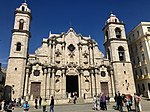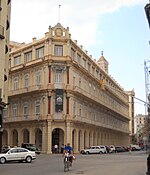Tacón Theatre
1830s establishments in Cuba19th-century architecture in CubaBuildings and structures in HavanaConcert halls in CubaNeoclassical architecture in Cuba ... and 3 more
Opera houses in CubaTheatres completed in 1838Theatres in Havana

The Teatro Tacón (Tacón Theatre) opened in 1838 in Havana, Cuba. Its auditorium contained 2,750 seats. It was built by Pancho Martí, a businessman from Barcelona who moved to Havana. In 1847 Bottesini's opera Cristoforo Colombo premiered there. By 1855, so many people attended events that the city issued parking regulations for carriages on performance nights.
Excerpt from the Wikipedia article Tacón Theatre (License: CC BY-SA 3.0, Authors, Images).Tacón Theatre
Paseo de Martí (Paseo del Prado), Havana
Geographical coordinates (GPS) Address Nearby Places Show on map
Geographical coordinates (GPS)
| Latitude | Longitude |
|---|---|
| N 23.137039 ° | E -82.359289 ° |
Address
Gran Teatro de La Habana
Paseo de Martí (Paseo del Prado)
10000 Havana (Prado)
Havana, Cuba
Open on Google Maps











